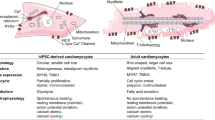Abstract
Cardiomyocytes are the fundamental cells of the heart and play an important role in engineering of tissue constructs for regenerative medicine and drug discovery. Therefore, the development of culture conditions that can be used to generate functional cardiomyocytes to form cardiac tissue may be of great interest. In this study, isolated neonatal rat cardiomyocytes were cultured with several culture conditions in vitro and characterized for cell proliferation, myofibril organization, and cardiac functionality by assessing cell morphology, immunocytochemical staining, and time-lapse confocal scanning microscopy. When cardiomyocytes were cultured in liver cell line derived conditioned medium without exogenous growth factors and cytokines, the cell proliferation increased, cell morphology was highly elongated, and subsequent myofibril organization was highly developed. These developed myofibril organization also showed high level of contractibility and synchronization, representing high functionality of cardiomyocytes. Interestingly, many of the known factors in hepatic conditioned medium, such as insulin-like growth factor II (IGFII), macrophage colony-stimulating factor (MCSF), leukemia inhibitory factor (LIF), did not show similar effects as the hepatic conditioned medium, suggesting the possibility of synergistic activity of the several soluble factors or the presence of unknown factors in hepatic conditioned medium. Finally, we demonstrated that our culture system could provide a potentially powerful tool for in vitro cardiac tissue organization and cardiac function study.
Similar content being viewed by others
References
Abramoff, M.D., Magalhaes, P.J., and Ram, S.J. (2004). Image processing with image. J. Biophotonics Int. 11, 36–42.
Bai, Y., Muragaki, Y., Obata, K., Iwata, K., and Ooshima, A. (1986). Immunological properties of monoclonal antibodies to human and rat prolyl 4-hydroxylase. J. Biochem. 99, 1563–1570.
Bashur, C.A., Dahlgren, L.A., and Goldstein, A.S. (2006). Effect of fiber diameter and orientation on fibroblast morphology and proliferation on electrospun poly(D,L-lactic-co-glycolic acid) meshes. Biomaterials 27, 5681–5688.
Engelmann G.L., McTiernan C., Gerrity R.G., and Samarel A.M. (1990). Serum-free primary cultures of neonatal rat cardiomyocytes: cellular and molecular applications. Technique 2, 279–291.
Grounds, M.D., White, J.D., Rosenthal, N., and Boqoyevitch, M.A. (2002). The role of stem cells in skeletal and cardiac muscle repair. J. Histochem. Cytochem. 50, 589–610.
Husmann, I., Soulet, L., Gautron, J., Martelly, I., and Barritault, D. (1996). Growth factors in skeletal muscle regeneration. Cytokine Growth Factor Rev. 7, 249–258.
Hwang, Y.S., Randle, W.L., Bielby, R.C., Polak, J.M., and Mantalaris, A. (2006). Enhanced derivation of osteogenic cells from murine embryonic stem cells after treatment with HepG2-conditioned medium and modulation of the embryoid body formation period: application to skeletal tissue engineering. Tissue Eng. 12, 1381–1392.
LaFramboise, W.A., Scalise, D., Stoodley, P., Graner, S.R., Guthrie, R.D., Magovern, J.A., and Becich, M.J. (2007). Cardiac fibroblasts influence cardiomyocyte phenotype in vitro. Am. J. Physiol. 292, C1799–1808.
Lake, J., Rathjen, J., Remiszewski, J., and Rathjen, P.D. (2000). Reversible programming of pluripotent cell differentiation. J. Cell Sci. 113(Pt 3), 555–566.
Langer, R., and Vacanti, J.P. (1993). Tissue engineering. Science 260, 920–926.
Mezzasoma, L., Biondi, R., Benedetti, C., Floridi, C., Ciurnelli, R., Falcinelli, F., Onorato, M., Scaringi, L., Marconi, P., and Rossi, R. (1993). In vitro production of leukemia inhibitory factor (LIF) by Hep G2 hepatoblastoma cells. J. Biol. Regul. Homeost. Agents 7, 126–132.
Mummery, C., Ward, D., van den Brink, C.E., Bird, S.D., Doevendans, P.A., Opthof, T., Brutel de la Riviere, A., Tertoolen, L., van der Heyden, M., and Pera, M. (2002). Cardiomyocyte differentiation of mouse and human embryonic stem cells. J. Anatomy 200, 233–242.
Nishimura, M., and Naito, S. (2005). Tissue-specific mRNA expression profiles of human toll-like receptors and related genes. Biol. Pharmaceut. Bull. 28, 886–892.
Okazaki, T., Ebihara, S., Asada, M., Yamanda, S., Saijo, Y., Shiraishi, Y., Ebihara, T., Niu, K., Mei, H., Arai, H., et al. (2007). Macrophage colony-stimulating factor improves cardiac function after ischemic injury by inducing vascular endothelial growth factor production and survival of cardiomyocytes. Am. J. Pathol. 171, 1093–1103.
Oppmann, B., Stoyan, T., Fischer, M., Voltz, N., Marz, P., and Rose-John, S. (1996). Alternative assay procedures for cytokines and soluble receptors of the IL-6 family. J. Immunol. Methods 195, 153–159.
Oyamada, M., Kimura, H., Oyamada, Y., Miyamoto, A., Ohshika, H., and Mori, M. (1994). The expression, phosphorylation, and localization of connexin 43 and gap-junctional intercellular communication during the establishment of a synchronized contraction of cultured neonatal rat cardiac myocytes. Exp. Cell Res. 212, 351–358.
Pisconti, A., Brunelli, S., Di Padova, M., De Palma, C., Deponti, D., Baesso, S., Sartorelli, V., Cossu, G., and Clementi, E. (2006). Follistatin induction by nitric oxide through cyclic GMP: a tightly regulated signaling pathway that controls myoblast fusion J. Cell Biol. 172, 233–244.
Poss, K.D., Wilson, L.G., and Keating, M.T. (2002). Heart regeneration in zebrafish. Science 298, 2188–2190.
Reinlib, L., and Field, L. (2000). Cell transplantation as future therapy for cardiovascular disease?: a workshop of the National Heart, Lung, and Blood Institute. Circulation 101, 182–187.
Semenkova, L.N., Dudich, E.I., Dudich, I.V., Shingarova, L.N., and Korobko, V.G. (1997). Alpha-fetoprotein as a TNF resistance factor for the human hepatocarcinoma cell line HepG2. Tumor Biol. 18, 30–40.
Soonpaa, M.H., and Field, L.J. (1998). Survey of studies examining mammalian cardiomyocyte DNA synthesis. Circ. Res. 83, 15–26.
Stonans, I., Stonane, E., Russwurm, S., Deigner, H.P., Bohm, K.J., Wiederhold, M., Jager, L., and Reinhart, K. (1999). HepG2 human hepatoma cells express multiple cytokine genes. Cytokine 11, 151–156.
Vitello, L., Radu, C., Malerba, A., Segat, D., Cantini, M., Carraro, U., and Baroni, M.D. (2004). Enhancing myoblast proliferation by using myogenic factors: a promising approach for improving fiber regeneration in sport medicine and skeletal muscle diseases. Basic Appl. Myol. 14, 45–51.
White, J.D., Davies, M., and Grounds, M.D. (2001). Leukaemia inhibitory factor increases myoblast replication and survival and affects extracellular matrix production: combined in vivo and in vitro studies in post-natal skeletal muscle. Cell Tissue Res. 306, 129–141.
Author information
Authors and Affiliations
Corresponding author
Additional information
These authors contributed equally to this work.
About this article
Cite this article
Kim, J., Hwang, YS., Chung, A.M. et al. Liver cell line derived conditioned medium enhances myofibril organization of primary rat cardiomyocytes. Mol Cells 34, 149–158 (2012). https://doi.org/10.1007/s10059-012-0019-0
Received:
Revised:
Accepted:
Published:
Issue Date:
DOI: https://doi.org/10.1007/s10059-012-0019-0




